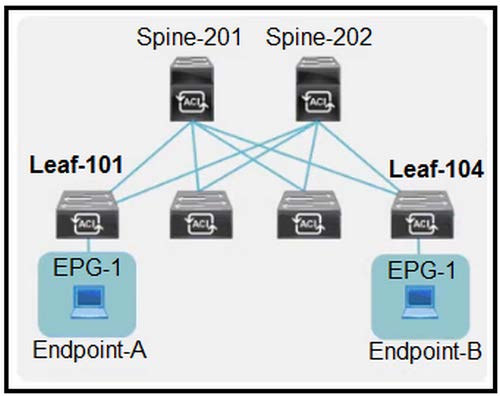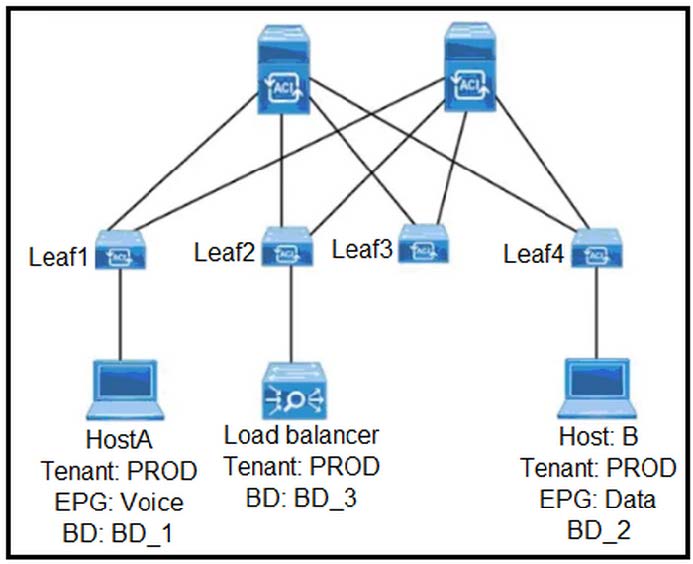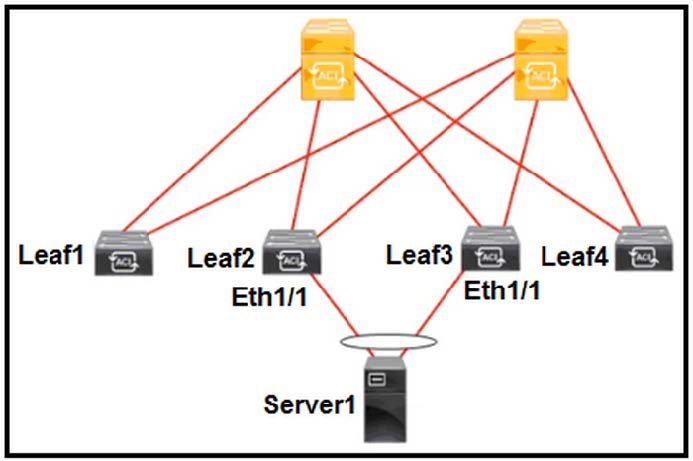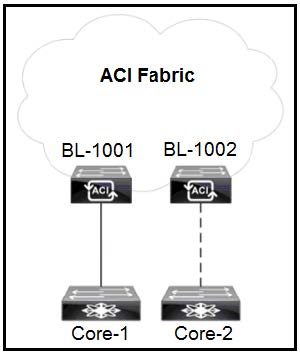Exam Details
Exam Code
:300-620Exam Name
:Implementing Cisco Application Centric Infrastructure (DCACI)Certification
:CCNP Data CenterVendor
:CiscoTotal Questions
:309 Q&AsLast Updated
:Aug 09, 2025
Cisco CCNP Data Center 300-620 Questions & Answers
-
Question 11:
Refer to the exhibit.

Endpoint-A must communicate with Endpoint-B, but Leaf-101 has not learned the location of Endpoint-B. Which step must Leaf-101 take before sending the data?
A. Leaf-101 forwards the packet to the anycast proxy VTEP IP.
B. Leaf-101 creates an eVXLAN tunnel to Leaf-104.
C. Leaf-101 sends the packet to the Spine-201.
D. Leaf-101 broadcasts an ARP request on a link to one of the spines.
-
Question 12:
Refer to the exhibit.

An engineer plans to upgrade the Cisco ACI fabric. Leaf1 and Leaf2 are deployed in a VPC. The fabric is peering with R1 using BGP protocol.
Which two actions upgrade the fabric nondisruptively? (Choose two.)
A. Configure the Graceful upgrade option.
B. Disable the BGP neighborship between Cisco ACI fabric and R1.
C. Enable the Graceful Insertion and Removal option.
D. Configure one maintenance group for every leaf.
E. Create one update group for all spines.
-
Question 13:
Refer to the exhibit.

A load balancer is connected to the Cisco ACI fabric using a single interface. The load balancer is performing source and destination NAT. A service graph is configured on the Cisco ACI. Which action must be taken to allow traffic from host A to pass through the load balancer before reaching host B?
A. Apply PBR on contract between the load balancer and application EPGs.
B. Disable unicast routing on the bridge domain BD_2.
C. Configure limit IP learning to subnet on BD_3.
D. Set the default gateway for host B on the load balancer.
-
Question 14:
Refer to the exhibit.

A Cisco ACI fabric has these configurations:
1.
VPC exists between Leaf2 and Leaf3.
2.
A switch profile called SW_Prof exists.
3.
A switch selector called SW_Selec exists.
4.
An interface selector named Int_Selec exists.
5.
An interface profile named Int_Prof exists.
Which two sets of actions must the engineer perform to connect Server1 to Leaf2 and Leaf3 using VPC? (Choose two.)
A. Map switch selector SW_Selec under switch profile SW_Prof. Add Leaf2 and Leaf3 node IDs under switch selector SW_Selec. Assign policy group to interface selector Int_Selec.
B. Add Leaf2 and Leaf3 node IDs under switch selector SW_Selec. Map switch profile SW_Prof under switch selector SW_Selec. Create the explicit VPC group from access policies.
C. Create the explicit VPC group from fabric policies. Map interface Eth1/1 under interface selector Int_Selec. Assign policy group to interface selector Int_Selec.
D. Add Leaf2 and Leaf3 node IDs under switch profile SW_Prof. Map Int_Selec under Int_Prof. Assign policy group to interface profile Int_Prof.
E. Create the explicit VPC group from access policies. Map Interface Eth1/1 under interface selector Int_Selec. Map Int_Selec under Int_Prof.
-
Question 15:
A Cisco ACI leaf switch receives an ARP request packet from a host that is attached to a bridge domain with unicast routing enabled. Which information does the leaf switch learn?
A. the local endpoint source IP address
B. the MAC and IP addresses of the local endpoint
C. the remote endpoint IP address
D. the source IP and destination IP addresses
-
Question 16:
Refer to the exhibit.

A tenant is configured with a single L3Out and a single-homed link to the core router called Core-1. An engineer must add a second link to the L3Out that connects to the Core-2 router. Which action allows traffic from Core-2 to BL-1002 to have the same connectivity as the traffic from Core-1 to BL-1001?
A. Add a second OSPF interface profile to the logical interface profile.
B. Add a second interface to the external domain to the existing L3Out.
C. Add a second path to the logical interface profile of the existing L3Out.
D. Add a second subnet to the external EPG to the existing L3Out.
-
Question 17:
Refer to the exhibit.

An engineer associated EPG-1 with a VMM domain called VMware/west. The VLAN pool west-VLP is configured in VMware/west, and the VMware/west is associated with the AEP called VMware/west-AEP. The corresponding port group failed to be automatically created in vCenter. Which action must the engineer take to resolve the missing port group?
A. Configure VMware/west-AEP with the correct vCenter credentials.
B. Include VLANs in the VMware/west-VLP.
C. Add a static range to VMware/west-VLP.
D. Associate VMware/west-AEP with a physical domain.
-
Question 18:
A network engineer must optimize a Cisco ACI multi-pod deployment. Both pods are using the same pod policy group. The customer requirement is to avoid inter-pod traffic loss in case of planned or unplanned spine reload. Which action accomplishes this goal?
A. Configure the COOP type as compatible in COOP Group Policy.
B. Configure MACsec in the MACsec Fabric Interface Policy.
C. Configure a lower IS-IS metric for redistributed routes in ISIS Policy.
D. Configure all spines as Route Reflectors in the BGP Route Reflector Policy.
-
Question 19:
An engineer must configure a service graph for the policy-based redirect to redirect traffic to a transparent firewall. The policy must be vendor-agnostic to support any firewall appliance. Which two actions accomplish these goals? (Choose two.)
A. Set Context Aware to Single.
B. Set the Service Type to Other.
C. Set Promiscuous Mode to True.
D. Set Function Type to L2.
E. Set Managed to True.
-
Question 20:
All nodes in a Cisco ACI fabric are raising NTP faults. The Date and Time policy is configured with the IP address of two NTP servers and both servers are reachable via the out-of-band management network. Also, the out-of-band EPG has been selected as the management EPG. Which configuration clears the NTP faults?
A. Add the NTP server IPs to the external management instance profile.
B. Create a node management address policy that includes all nodes in the fabric.
C. Configure and apply an out-of-band contract to the out-of-band EPG.
D. Directly attach both NTP servers to the Cisco ACI fabric via a leaf switch.
Related Exams:
300-610
Designing Cisco Data Center Infrastructure (DCID)300-615
Troubleshooting Cisco Data Center Infrastructure (DCIT)300-620
Implementing Cisco Application Centric Infrastructure (DCACI)300-630
Implementing Cisco Application Centric Infrastructure - Advanced (DCACIA)300-635
Automating and Programming Cisco Data Center Solutions (DCAUTO)350-601
Implementing and Operating Cisco Data Center Core Technologies (DCCOR)
Tips on How to Prepare for the Exams
Nowadays, the certification exams become more and more important and required by more and more enterprises when applying for a job. But how to prepare for the exam effectively? How to prepare for the exam in a short time with less efforts? How to get a ideal result and how to find the most reliable resources? Here on Vcedump.com, you will find all the answers. Vcedump.com provide not only Cisco exam questions, answers and explanations but also complete assistance on your exam preparation and certification application. If you are confused on your 300-620 exam preparations and Cisco certification application, do not hesitate to visit our Vcedump.com to find your solutions here.